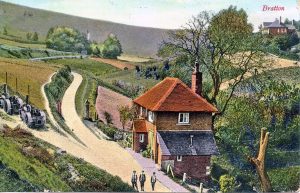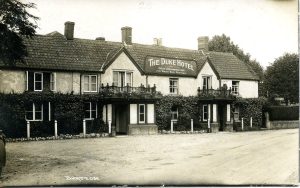Early Days
First Occupation
The first occupation of this area was almost certainly up to 6,000 years ago in the area now known as Bratton Camp on the east boundary of the parish, above the White Horse. Bratton Camp (or Castle) was built between 800 BC and 50 AD. Settlement there, by the Dobunni tribe, continued into the Romano-British period.
Middle Ages
Various isolated finds of Roman material have been discovered on the lower ground between Bratton and Westbury, although there is no remaining evidence of Romano-British settlement.
The Angles and Saxons then arrived and three settlements were created in the relatively protected areas with springs in the small valleys below Bratton Camp. These all have Saxon names: Braectun (a settlement with newly cultivated land): Stoc (a secondary or dependent settlement, almost certainly of Westbury and later called Stoke and then Littlestoke): and Milbourne (a stream with a mill, later alternatively called Stradbrook). Littlestoke almost entirely disappeared, with the exception of St James’ Church, probably as a result of the Black Death in the mid-14th century. In the Saxon, Norman and subsequent Middle Age periods, the area of Bratton was owned by various manors, with the ownership changing often. Buildings were generally short-lasting, with the exception of the church which was originally Norman, possibly built on the site of a Saxon chapel. By the 13th century some houses were built with timber frames with the oldest surviving example being the Court House (14th Century) in Braectun/Bratton. 
In 1377 poll tax payers in Bratton numbered 169.
Employment
In common with all English rural areas, the main occupation for people in Bratton was farming and related activities such as milling. There were several hill farms in the southern half of the parish, on Salisbury Plain, where grazing of sheep was predominant although some arable farming did take place in the south-eastern area. North of this, and also to the west of the current village, the land was mainly arable, and further north still were pasture and hay meadows. There were at least 24 farms within the parish boundary, a number that has substantially decreased in the past century. Four mills existed on the Milbourne: the lowest and probably the first, mentioned in 1221, was Lower Mill, off Lower Road: Bridge Mill was on the north side of the Bratton-Edington road; further upstream and south was Aldridge’s Mill, now converted to the three houses of
take place in the south-eastern area. North of this, and also to the west of the current village, the land was mainly arable, and further north still were pasture and hay meadows. There were at least 24 farms within the parish boundary, a number that has substantially decreased in the past century. Four mills existed on the Milbourne: the lowest and probably the first, mentioned in 1221, was Lower Mill, off Lower Road: Bridge Mill was on the north side of the Bratton-Edington road; further upstream and south was Aldridge’s Mill, now converted to the three houses of  Cleeve Terrace, beside the Stradbrook road; and the most southerly was Luccombe Mill, beside the Imber Road. The latter mill has been demolished but the house beside it, and the mill pond, remains. These mills were for originally for grinding corn but later one and possibly two of them were used in the cloth industry for fulling. In the 14th and 15th centuries Wiltshire was one of the most important clothing manufacturing areas in the country, with towns close to Bratton being prominent.
Cleeve Terrace, beside the Stradbrook road; and the most southerly was Luccombe Mill, beside the Imber Road. The latter mill has been demolished but the house beside it, and the mill pond, remains. These mills were for originally for grinding corn but later one and possibly two of them were used in the cloth industry for fulling. In the 14th and 15th centuries Wiltshire was one of the most important clothing manufacturing areas in the country, with towns close to Bratton being prominent.
17th Century
In the 17th century the Longleat Estate bought a considerable amount of land in Bratton parish. Its records mention many houses, cottages and farms that still exist today, mostly identifiable by their timber frames.
Records from this period show that in addition to farmers, Bratton had  fullers, weavers and clothiers. Furthermore they include a carpenter, blacksmith, tailor, cordwainer (boot and shoe maker), butcher and alehouse keeper, showing that Bratton was a largely self-sufficient village. Fruit farming was extensive in the village in the 19th and first half of the 20th centuries.
fullers, weavers and clothiers. Furthermore they include a carpenter, blacksmith, tailor, cordwainer (boot and shoe maker), butcher and alehouse keeper, showing that Bratton was a largely self-sufficient village. Fruit farming was extensive in the village in the 19th and first half of the 20th centuries.
The 18th century saw something of a building boom in Bratton, including Winters (towards the east end of Lower Road), Bratton House, and Smarts (now called Yew Trees, in Lower Road) and several smaller cottages. There was also a significant amount of re-building and extension of older houses, such as Grange Farm (Lower Road), Ballards (Bury Lane), Scotts Farm (also Bury Lane), Pear Tree Cottage (Court Lane) and Melbourne House (Melbourne Street). Brick was increasingly used as a building material.
Churches

St James’ Church (C of E) was originally a chapelry of Westbury. The Norman building was very extensively enlarged and rebuilt in 1400. After many attempts over 300 years it became an independent parish church in 1845, albeit remaining part of Westbury benefice. In 1995 it became a parish within a separate benefice (including Edington, Coulston, Erlestoke and Imber) but the rectory/vicarage remains in Bratton.
Non-conformist religion has been strong in Bratton for at least three centuries, largely due to the influence of prominent village families. There have been several chapels in various parts of the village but the one remaining is the Baptist Chapel (built 1734 and extended several times), which is still very popular and attracts a congregation from many neighbouring villages as well.
(built 1734 and extended several times), which is still very popular and attracts a congregation from many neighbouring villages as well.
Reeves Ironworks
 Robert and John Reeves founded Reeves Ironworks in about 1840, using their complementary skills of carpentry and blacksmith. This was established on the area that is now the village green and expanded rapidly with all functions needed to produce farming machinery. The workforce increased from about 40 in 1851 to 69 in 1914. However after WW2 the company was unable to compete with larger, international firms and went into receivership in 1970. The entire works was demolished in 1973.
Robert and John Reeves founded Reeves Ironworks in about 1840, using their complementary skills of carpentry and blacksmith. This was established on the area that is now the village green and expanded rapidly with all functions needed to produce farming machinery. The workforce increased from about 40 in 1851 to 69 in 1914. However after WW2 the company was unable to compete with larger, international firms and went into receivership in 1970. The entire works was demolished in 1973.
Schools

Although there were relatively few children in the village prior to the mid-20th century, several schools were established: The British School in Stradbrook (1844); the National (Anglican) School (probably from 1820 and now The Oratory at the top of The Butts); and Whitaker’s School (18th century and now Yew Trees in Lower Road). All these have eventually been converted to houses. The present Bratton Primary School was opened in c.1930.
Bratton today
Housing Development
The number of houses in Bratton increased very significantly in the 1970’s as a result of two large housing estates being built in infill areas. Southay, Ethandun and The Picquet were built in the mid-70’s and Manor Fields was built in the late-70’s. Rosenheim is a smaller estate and was built in 19xx. More recently houses have been built either individually or in quantities of up to four, all as infill developments.
Demography
According to the results from the 2021 Census the population of the Parish amounts to c.1,200 persons living in 512 households. Of these 512 homes 418 are owner occupies and 94 are rented mostly from housing associations.
Services
 Bratton a wide range of facilities and services available within the village. There were four pubs but now only one, The Duke, (dating from the early-19th century) remains, although it does include a popular restaurant. The individual food shops have also reduced to one, Central Stores, dating from 1906 and extended in 2002, which includes a bakery and post office. Bratton Surgery is an outpost of Westbury’s White Horse Health Centre, although it only offers consultation, basic nursing and a dispensary.
Bratton a wide range of facilities and services available within the village. There were four pubs but now only one, The Duke, (dating from the early-19th century) remains, although it does include a popular restaurant. The individual food shops have also reduced to one, Central Stores, dating from 1906 and extended in 2002, which includes a bakery and post office. Bratton Surgery is an outpost of Westbury’s White Horse Health Centre, although it only offers consultation, basic nursing and a dispensary.
Technically in Edington but generally considered to be in Bratton, Fitzroy Farm has a popular coffee shop and light restaurant, a hairdresser and Bratton Plant Centre. Several very small companies and sole-traders are run from houses in the village. Bratton benefits from two village halls: the Jubilee Hall (1887 and extended in 1987 and 2002) is the home of the Jubilee Players amateur dramatic group and is also hired regularly and for individual events; and the Church Institute (18xx) is the home of Bratton Silver Band and several other village organisations, many for children. The land for the Recreation Ground (beside Trowbridge Road) was donated in memory of Horace Seymour in 1998 and it now offers a cricket pitch, two football pitches and a trim trail as well as a large pavilion. Alongside these the Village has an Anglican and a Baptist Church, the Primary school and a recently established Pre-school.
